<span class="blue-highlight"<code>Non-fungible tokens (NFTs) are unique, digital items with blockchain-managed ownership. Examples include collectibles, game items, digital art, event tickets, domain names, and even ownership records for physical assets.</code></span>
If you’ve been living in the crypto world for a while, you’ve likely heard of the term “Non-Fungible Token”, or “NFT”. Maybe you’re a skeptic, a believer, or perhaps you still don’t really know what exactly a non-fungible token is. In any case, this post is for you!
As a marketplace for NFTs, OpenSea has a unique vantage point: we’ve seen nearly every NFT-related project that has come online since late 2017 when the first NFT standard emerged. In fact, we’ll bet you a Gods Unchained Card that if you ask us about an NFT project, we’ve heard of it and likely talked to the developers at some point! The NFT ecosystem is a tight-knit group of incredible innovators: everyone from enthusiasts to developers to gamers to entrepreneurs to artists. We’re honored to be a part of this community.
This post serves to provide an in-depth overview of non-fungible tokens: the technical anatomy of an ERC721, the history of the NFT, common misconceptions about NFTs, and the current state of the NFT market. We hope it will be relevant both to folks who are new to the space, as well as those who already know about NFTs but want to better understand the nuances of their inner workings.
<!--table of content !-->
What is a non-fungible token?
<span class="blue-highlight"<code>Non-fungible assets are just normal stuff. Fungible assets are the odd ones out!</code></span>
Most discussions about non-fungible tokens begin by introducing the idea of fungibility, which is defined as “able to replace or be replaced by another identical item”. We think this overcomplicates things. To get a better sense of what might constitute a non-fungible asset, just think about most of the stuff you own. The chair you’re sitting in, your phone, your laptop, anything you could go and sell on eBay. All of these fall under the category of non-fungible things.
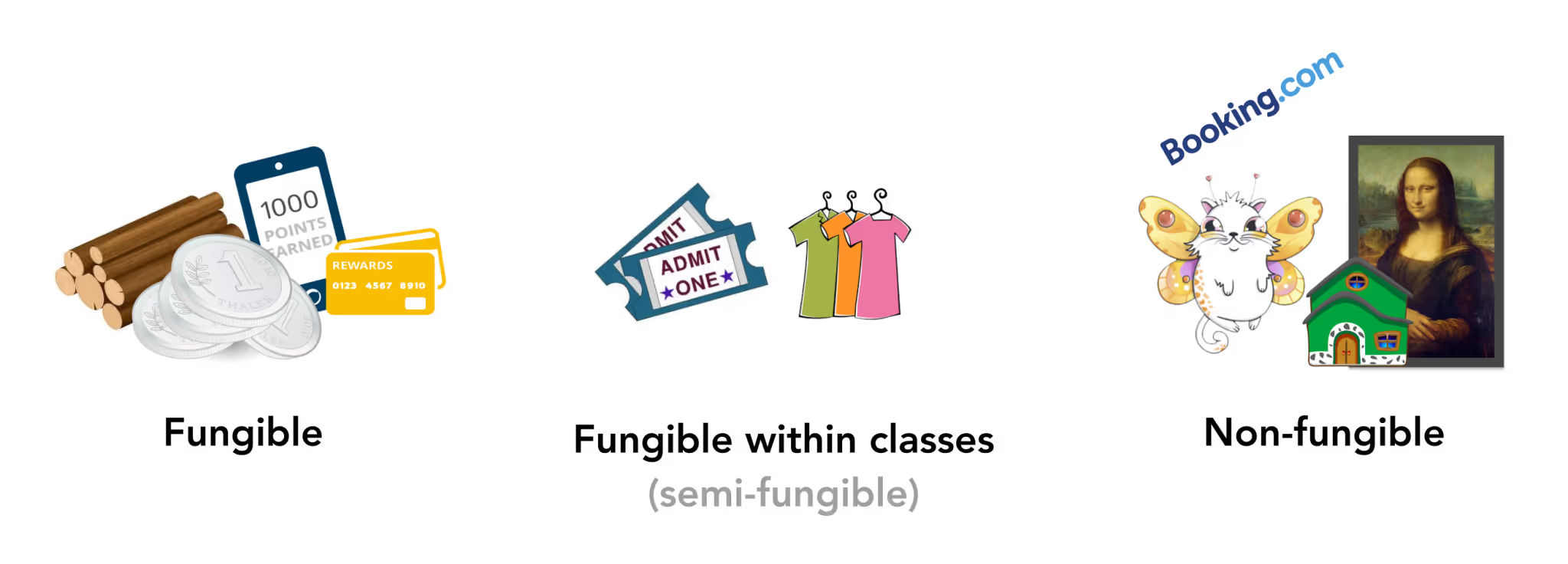
It turns out that fungible assets are actually the odd ones out. A currency is a classic example of a fungible asset. Five dollars is always five dollars no matter the serial number on the specific five-dollar bill, or whether its five dollars sitting in your bank account. The ability to replace a five-dollar bill with another five-dollar bill (or five ones, for that matter) is what makes currency fungible.
Note that fungibility is relative; it really only applies when comparing multiple things. Consider business class, economy class, and first-class flight tickets. Each ticket is roughly fungible within its class, but you couldn’t fairly swap a first-class ticket for a business class ticket. Even the chair you’re sitting in is roughly fungible with a chair of the same model, unless you’ve developed a special attachment to your particular chair.
Interestingly, fungibility can also be subjective. Back to the flight ticket example: a person that cares about sitting in a window seat vs. an aisle seat might not consider two economy class tickets interchangeable. Similarly, a rare penny might be worth 1 cent to me but worth much more to a coin collector. We’ll see that some of these nuances become important when representing these items on blockchains.
Blockchain-based non-fungible tokens
Just as we had digital currencies (think airline points, in-game currencies) before cryptocurrencies emerged, we’ve had non-fungible digital assets since the dawn of the internet. Domain names, event tickets, in-game items, even handles on social networks like Twitter or Facebook, are all non-fungible digital assets; they just vary in their tradeability, liquidity, and interoperability. And many of them are incredibly valuable: Epic Games made $2.4 billion in revenue selling costumes in their free-to-play game Fortnite in 2018 alone, the market for event tickets is projected to reach $68 billion in 2025, and the market for domain names continues to see solid growth.
<span class="blue-highlight"<code>We have tons of digital stuff, we've just never really owned it.</code></span>
So it’s clear we already have tons of digital stuff. But to what extent do we “own” these digital things? If digital ownership only means that an item belongs to you and not someone else, then you own them in some sense. But if digital ownership is more like ownership in the physical world (the freedom to hold and transfer indefinitely), this doesn’t always seem to be the case with digital assets. Rather, you own these assets in specific contexts, which may or may not make moving them around easy. Try to sell a Fortnite skin on eBay, and you’ll discover the difficulty of moving digital assets from one person to another.
This is where blockchains come in! Blockchains provide a coordination layer for digital assets, giving users ownership and management permission. Blockchains add several unique properties to non-fungible assets that change the user and developer relationships with these assets.
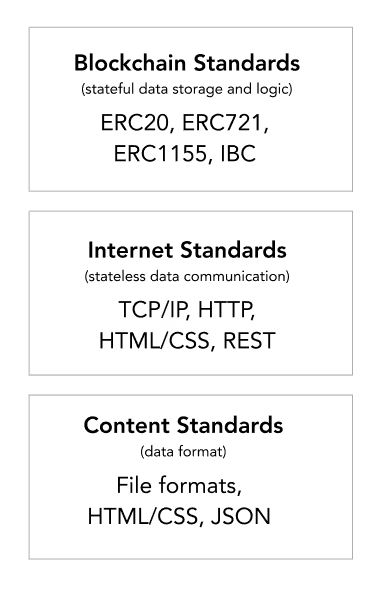
Standardization
Traditional digital assets—from event tickets to domain names—have no unified representation in the digital world. A game likely represents its in-game collectibles in an entirely different way than an event ticketing system. By representing non-fungible tokens on public blockchains, developers can build common, reusable, inheritable standards relevant to all non-fungible tokens. These include such basic primitives as ownership, transfer, and simple access control. Additional standards (specifications for how to display an NFT, for example) can be layered on top for rich display inside of applications.
These are analogous to other building blocks of the digital world, like the JPEG or PNG file format for images, HTTP for requests between computers, and HTML / CSS for displaying content on the web. Blockchains add a layer on top that gives developers a brand new set of stateful primitives on which to build applications.
Interoperability
Non-fungible token standards allow non-fungible tokens to move easily across multiple ecosystems. When a developer launches a new NFT project, these NFTs are immediately viewable inside dozens of different wallet providers, tradeable on marketplaces, and, most recently, displayable inside of virtual worlds. This is possible because open standards provide a clear, consistent, reliable, and permissioned API for reading and writing data.
Tradeability
The most compelling feature enabled by interoperability is free trade on open marketplaces. For the first time, users can move items outside of their original environments and into a marketplace where they can take advantage of sophisticated trading capabilities, like eBay-style auctions, bidding, bundling, and the ability to sell in any currency, like stablecoins and application-specific currencies.
For game developers specifically, tradeability of assets represents a transition from a closed economy to an open, free-market economy. Game developers no longer have to manage every piece of their economy: from the supply of resources to pricing to capital controls. Instead, they can let free markets do the heavy lifting!
Liquidity
Instant tradeability of non-fungible tokens will lead to higher liquidity. NFT marketplaces can cater to a variety of audiences—from hardcore traders to more novice players—allowing for greater exposure of the assets to a wider pool of buyers. In the same way that the ICO boom of 2017 gave birth to a new asset class driven by instantly liquid tokens, NFTs expand the market for unique digital assets.
Immutability and provable scarcity
Smart contracts allow developers to place hard caps on the supply of non-fungible tokens and enforce persistent properties that cannot be modified after the NFTs are issued. For example, a developer can enforce programmatically that only a specific number of a specific rare item can be created, while keeping the supply of more common items infinite. Developers can also enforce that specific properties do not change over time by encoding them on-chain. This is particularly interesting for art, which relies heavily on the provable scarcity of an original piece.
Programmability
Of course, like traditional digital assets, NFTs are fully programmable. CryptoKitties (which we’ll talk about later) baked in a breeding mechanic directly into the contract that represents the digital cats. Many of today’s NFTs have more complex mechanics, like forging, crafting, redeeming, random generation, etc. The design space is full of possibilities.
Non-fungible token standards
Standards are part of what makes non-fungible tokens powerful. They give developers the guarantee that assets will behave in a specific way and describe exactly how to interact with the basic functionality of the assets.
ERC721
Pioneered by CryptoKitties, ERC721 was the first standard for representing non-fungible digital assets. ERC721 is an inheritable Solidity smart contract standard, meaning that developers can easily create new ERC721-compliant contracts by importing it from the OpenZeppelin library (we have a helpful tutorial on creating your first ERC721 contract here). ERC721 is actually relatively simple: it provides a mapping of unique identifiers (each of which represents a single asset) to addresses, which represent the owner of that identifier. ERC721 also provides a permissioned way to transfer these assets, using the <span id="code" class="pink-text" style="color: #e83e8c;" fs-test-element="code">transferFrom</span> method.
If you think about it, these two methods are really all you need to represent an NFT: a way to check who owns what and a way to move things around. There are a few other bells and whistles to the standard (some of which turn out to be very important for NFT marketplaces), but the core of ERC721 is quite basic.
ERC1155
ERC1155, pioneered by the Enjin team, brings the idea of semi-fungibility to the NFT world. With ERC1155, IDs represent not single assets but classes of assets. For example, an ID might represent “swords”, and a wallet could own 1,000 of these swords. In this case, the <span id="code" class="pink-text" style="color: #e83e8c;" fs-test-element="code">balanceOf</span> method would return the number of swords owned by a wallet, and a user can transfer any number of these swords by calling <span id="code" class="pink-text" style="color: #e83e8c;" fs-test-element="code">transferFrom</span> with the “sword” ID.
One advantage of this type of system is efficiency: with ERC721, if a user wanted to transfer 1,000 swords, they would need to modify the smart contract’s state (by calling the <span id="code" class="pink-text" style="color: #e83e8c;" fs-test-element="code">transferFrom</span> method) for 1,000 unique tokens. With ERC1155, the developer need only call <span id="code" class="pink-text" style="color: #e83e8c;" fs-test-element="code">transferFrom</span> with quantity 1,000 and perform a single transfer operation. This increased efficiency, of course, comes with the loss of information: we can no longer trace the history of an individual sword.
Note also that ERC1155 provides a superset of ERC721 functionality, meaning that an ERC721 asset could be built using ERC1155 (you’d simply have a separate ID and quantity 1 for each asset). Due to these advantages, we’ve recently witnessed growing adoption of the ERC1155 standard. OpenSea recently developed a repository on Github for getting started with the ERC1155 standard.
.avif)
Composables
Composables, led by the ERC-998 standard, provide a template by which NFTs can own both non-fungible and fungible assets. There have only been several composable NFTs deployed on mainnet, but we think there are incredibly exciting opportunities to put them to use!
…a cryptokitty may own a scratching post and a feeding dish; the dish may contain some amount of fungible “chow” tokens. If I sell the cryptokitty, I sell all of the belongings of the cryptokitty.
Non-Ethereum standards
While Ethereum is where most of the action is currently happening, there are several other NFT standards emerging on other chains. DGoods, pioneered by the Mythical Games team, is focused on providing a feature-rich cross-chain standard starting with EOS. The Cosmos project is also developing an NFT module that can be leveraged as part of the Cosmos SDK.
Non-fungible token metadata
As mentioned, the <span id="code" class="pink-text" style="color: #e83e8c;" fs-test-element="code">ownerOf</span> method provides a way to look up the owner of an NFT. For example, by querying <span id="code" class="pink-text" style="color: #e83e8c;" fs-test-element="code">ownerOf(1500718)</span> on the CryptoKitties smart contract, we can see that the owner of CryptoKitty #1500718 at the time of writing is an account with the address 0x6452… This can be verified by visiting their CryptoKitty on OpenSea or on CryptoKitties.co.

But how do OpenSea and CryptoKitties figure out what CryptoKitty #1500718 looks like? And what about its name and unique attributes?
This is where metadata comes in. Metadata provides descriptive information for a specific token ID. In the case of the CryptoKittty, the metadata is the name of the cat, the picture of the cat, a description, and any additional traits (called “cattributes”, in the case of CryptoKitties). In the case of an event ticket, the metadata might include the date of the event and the type of ticket, in addition to a name and description. The metadata for the above cat might look something like this:
The question becomes how and where to store this data such that it can be accessed by applications that care about the NFT.
On-chain vs. off-chain
The first decision for developers is what metadata to represent on-chain vs. off-chain. That is, do you bake the metadata directly into the smart contract representing the tokens, or do you host it separately?
On-chain Metadata
The benefits of representing metadata on-chain are: 1) it permanently resides with the token, persisting beyond the lifecycle of any given application, and 2) it can change in accordance with on-chain logic. Point #1 is important if assets are intended to have long-lasting value far beyond their original creation. For example, a piece of digital art is expected to persist throughout the ages, regardless of whether the original website that was used to create the art is still around. It therefore is important that its metadata persist alongside the lifecycle of the token identifier.
Additionally, on-chain logic may need to interact with the metadata. In the case of CryptoKitties, for example, the “generation” of the CryptoKitty influences how quickly a CryptoKitty can breed, and breeding all happens on chain (higher generation cats bred more slowly). So the logic inside of the smart contract needs to be able to read the metadata from its internal state.
Off-chain Metadata
Despite these benefits, most projects store their metadata off-chain simply due to the current storage limitations of the Ethereum blockchain. The ERC721 standard, therefore, includes a method called <span id="code" class="pink-text" style="color: #e83e8c;" fs-test-element="code">tokenURI</span> that developers can implement to tell applications where to find the metadata for a given item.
The <span id="code" class="pink-text" style="color: #e83e8c;" fs-test-element="code">tokenURI</span> method returns a public URL. This, in turn, returns a JSON dictionary of data, something like the example dictionary for the CryptoKitty above. This metadata should conform to the official ERC721 metadata standard for it to be picked up by applications like OpenSea. At OpenSea, we want to give developers the ability to build rich metadata that can be displayed inside of our marketplace, so we’ve added extensions to the ERC721 metadata standard that allows developers to include things like traits, animations, and background colors.
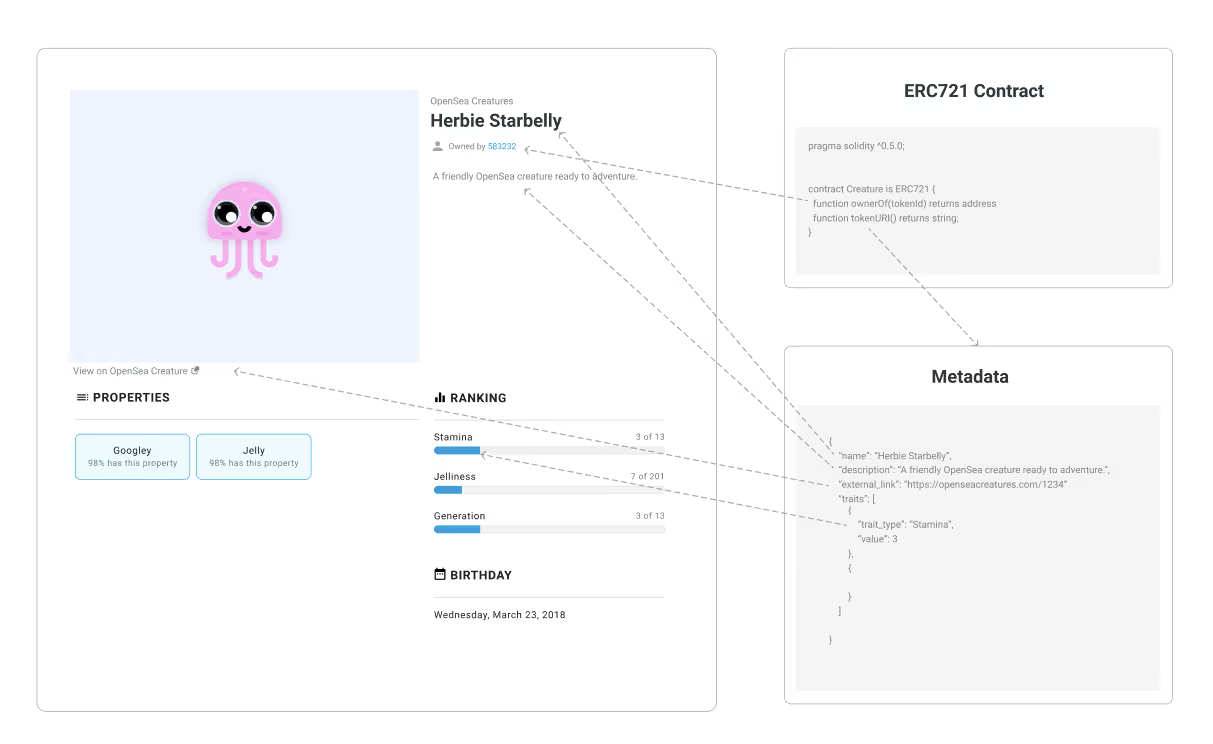
Off-chain storage solutions
If you’re storing your metadata off-chain, you have a couple of options:
Centralized servers
The simplest way to store metadata is on a centralized server somewhere, or a cloud storage solution like AWS. Of course, this has disadvantages: 1) the developer can change the metadata at will, 2) if the project goes offline, the metadata could disappear from its original source. To mitigate problem #2, there are now several services (OpenSea included) that will cache the metadata on its own servers in order to ensure that it can be efficiently served to users even if the original hosting solution goes down.
IPFS
An increasing number of developers, particularly in the digital art space, are using the InterPlanetary File System (IPFS) to store metadata off-chain. IPFS is a peer-to-peer file storage system that allows content to be hosted across computers, such that the file is replicated in many different locations. This ensures that A) the metadata is immutable, as it is uniquely addressed by the hash of the file, and B) as long as there are nodes willing to host the data, the data will persist over time. There are now services like Pinata that make this process simpler for developers by handling the infrastructure for deploying and managing IPFS nodes, and the highly-anticipated Filecoin network will (in theory) add a layer on top of IPFS to incentivize nodes to host files.
History of non-fungible tokens (2017 – 2020)
Now that we understand what non-fungible tokens are and how they can be built, let’s dive into how they came about.
– 0 BC: Before CryptoKitties
Experiments in NFTs began with the emergence of colored coins on the Bitcoin network. Rare Pepes, illustrations of the Pepe the Frog character built on the Bitcoin counterparty system, were among the first. Some of them actually sold on eBay, and a set of Rare Pepes later sold in a live auction in New York.
The first Ethereum-based NFT experiment was CryptoPunks, which consisted of 10,000 unique collectible punks, each of which has a set of unique characteristics. Built by Larva Labs, CryptoPunks featured an on-chain marketplace that could be used with wallets like MetaMask, lowering the barrier to entry to interact with NFTs. Today, given their limited supply and strong brand among the early adopter community, CryptoPunks are likely the best candidates for true digital antiques. Additionally, the fact that punks live on the Ethereum network makes them interoperable with marketplaces and wallets (though slightly less-so than newer assets, as they pre-date the ERC721 standard).

0 BC: Birth of CryptoKitties
CryptoKitties was the first project to take NFTs to the mainstream. Launched in late 2017 at the ETH Waterloo hackathon, CryptoKitties featured a primitive on-chain game that allowed users to breed digital cats together to produce new cats of varying rarity. “Generation 0” cats were auctioned off in a declining-price Dutch auction, and new cats could also be sold on a secondary market.
While some in the gaming community later labeled CryptoKitties “not a real game”, the team actually did quite a lot to pioneer on-chain game mechanics given the design constraints of the blockchain. For one, they built an on-chain breeding algorithm, hidden inside of a closed-source smart contract that determined the genetic code of a cat (which in-turn determined its “cattributes”). The CryptoKitties team even ensured the randomness of the breeding through a sophisticated incentive system and had the foresight to reserve certain low-ID cats for later use as promotional tools. Lastly, they pioneered a Dutch auction contract that later became one of the primary price discovery mechanisms for NFTs. The remarkable foresight of the CryptoKitties team gave the NFT space a major boost, early in its life.
We think the virality of CryptoKitties can be boiled down into:
Speculative mechanics
The breeding and trading mechanics of CryptoKitties led to a clear path to profit: buy up a couple of cats, breed them to make a rarer cat, flip the cat, repeat (or simply buy up a rare cat and hope that someone will come along and buy it). This fueled the growth of a breeder community: users who were dedicated to breeding and flipping rare cats. As long as a new set of users come in and play the games, prices would rise.
At the height of the mania, CryptoKitties saw nearly 5,000 ETH in volume, with Founder Cat #18 selling for 253 ETH ($110,000 at the time of sale). This sale was later bested by the 600 ETH sale of Dragon, which was $170,000 at the time (September 2018), though many speculate that the Dragon sale was illegitimate. These high prices drew more users into the gold rush.
Viral story
Another piece of CryptoKitties’ success was the story. CryptoKitties were adorable, shareable, and fun — and the idea of buying a $1,000 digital cat was so absurd that it made a great news story. Additionally, the smart contract’s overeager users “broke Ethereum”, which made for a story in and of itself. Since Ethereum can only process a limited number of transactions at a time (about 15 transactions/second), higher throughput on the network led to a growing pending transaction pool and increased gas prices. Daily average pending transactions rose from 1,500 transactions to 11,000 transactions. New potential cat buyers were paying astronomical fees and waiting hours on end for their transactions to be confirmed.
These factors led to the “CryptoKitty bubble”: new demand entering the CryptoKitty world, prices rising, and rising prices bringing in new demand. Of course, all bubbles must eventually pop. In early December, average kitty prices started dropping and volume declined. Many realized that the CryptoKitties gameplay, which was primitive relative to “real games”, wouldn’t retain a wider audience beyond speculators. Once the novelty wore off, the market suffered. Today, CryptoKitties does around 50 ETH of volume per week.
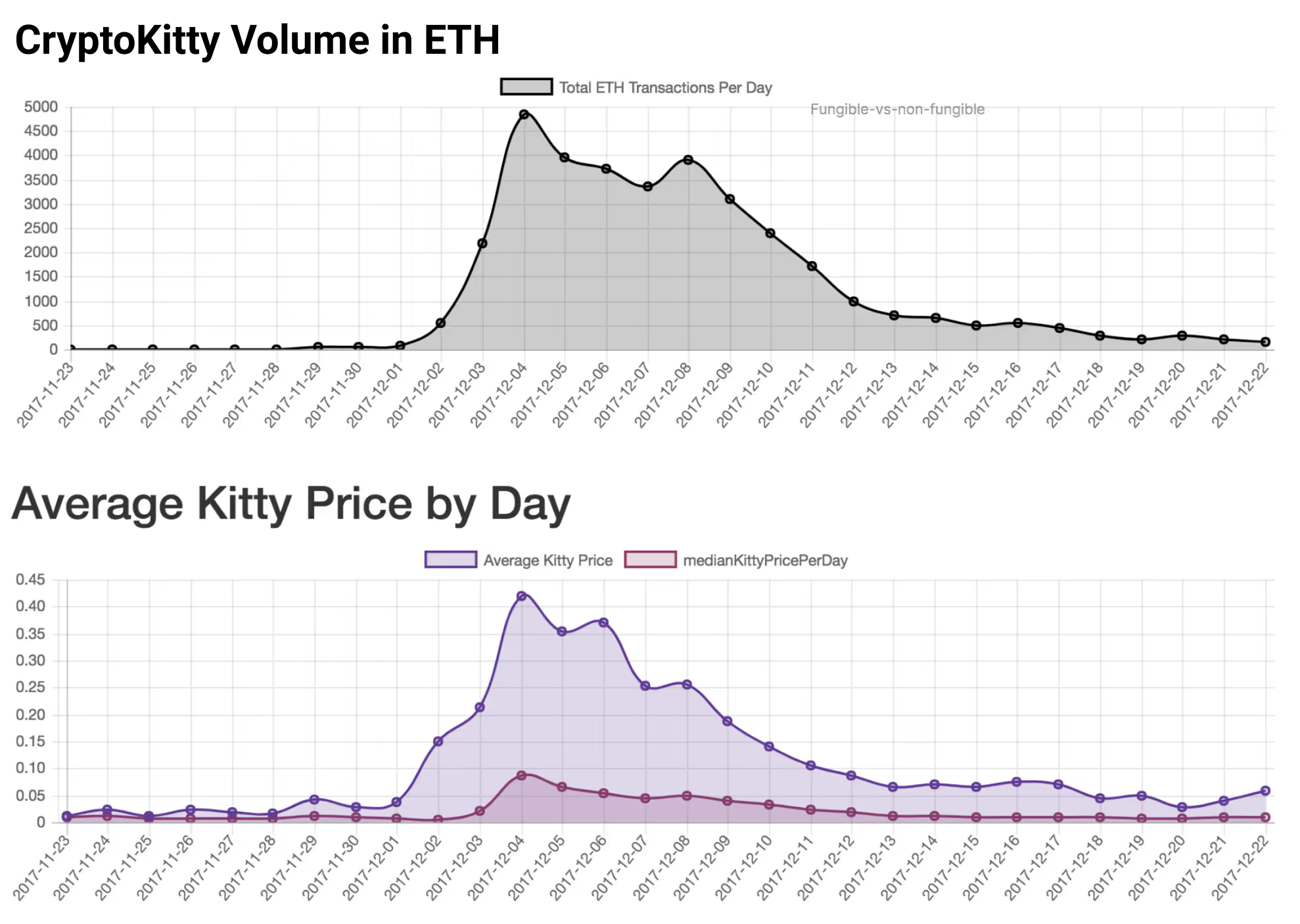
2018: Hype, hot-potato games, and layer 2
Despite the market downturn, the early days of CryptoKitties provided a magical moment for many. For the first time, a team had deployed a non-financial blockchain-based application that made its way to the tech mainstream, albeit only for a few weeks. After CryptoKitties, NFTs underwent a second small hype cycle in early 2018 as investors and entrepreneurs started to think about a new way to own digital stuff.
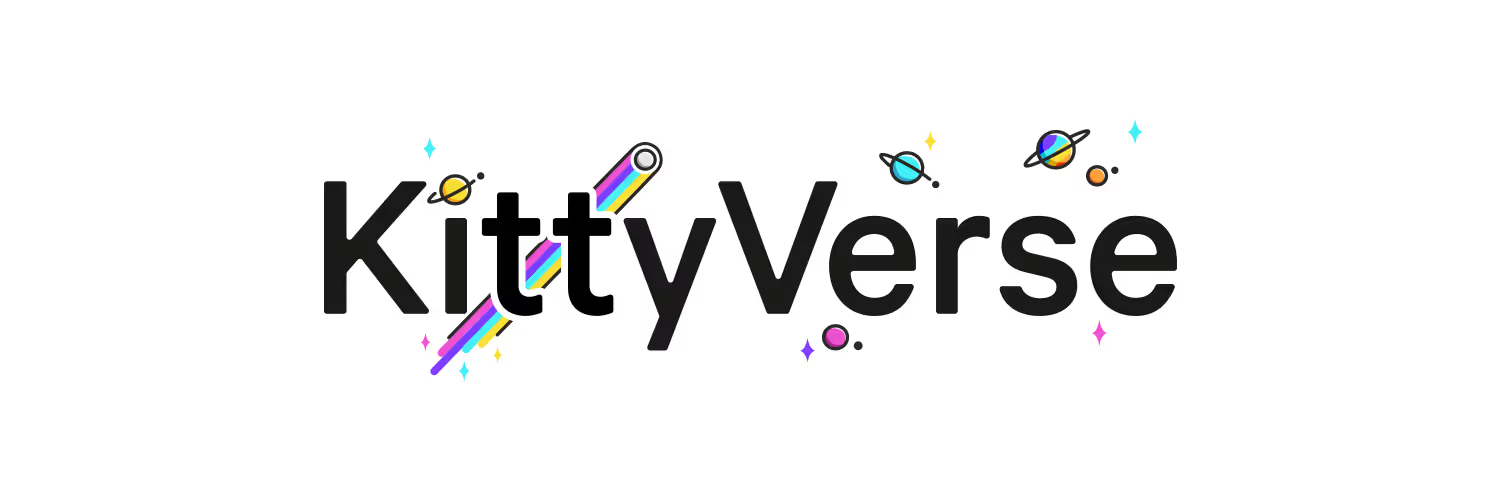
Layer 2 games and experiences
The period after CryptoKitties saw the emergence of innovative “layer two” games, games that were built on top of CryptoKitties by third-party developers with no affiliation to the original CryptoKitties team. The magic of CryptoKitties was that these sorts of experiences could be developed “permmissionlessly”: developers could simply layer their own applications on top of the public CryptoKitty smart contract. CryptoKitties could, in some sense, take on a life of their own outside of their original environment. Kitty Race, for example, allowed you to race your CryptoKitties against each other to win ETH, and KittyHats let users accessorize their CryptoKitties with hats and paintings. Later, Wrapped Kitties combined Kitties and DeFi by letting you turn your CryptoKitties into fungible ERC20 tokens to be traded on decentralized exchanges, which had all sorts of interesting ramifications for the CryptoKitty market. Dapper Labs (the newly founded company behind CryptoKitties) embraced these projects with the formation of the KittyVerse.

Hot Potatoes
This period also saw the emergence of “hot potato” games. If you already know what a “hot potato” game is, you’re a true NFT OG. In January 2018, a game called CryptoCelebrities launched. The mechanic was simple. First, buy a collectible celebrity NFT. Immediately, the celebrity becomes purchasable (or “snatchable”) for a higher price, some increment of the previous price. When someone buys your celebrity, you make the difference between your purchase price and the new purchase price (minus a developer fee). As long as there’s someone willing to buy your celebrity, you’ll profit. However, if you’re caught as the last one holding the celebrity, you’ll be in for a loss.
The CryptoCelebrity mechanic turned out to be incredibly viral due to this speculative mechanic, with celebrities like Donald Trump selling for astronomically high prices (123 ETH, or $137k at the time). While the CryptoCelebrity game likely harmed the space overall, we actually think experimentation with pricing and auction mechanics is an exciting piece of the design space for NFTs.
Venture Capital interest
Venture capital and crypto funds also grew curious about the NFT space in early 2018. CryptoKitties raised $12 million from top tier investors and another $15 million in November. Rare Bits, founded by the co-founders of Farmville, raised $6 million in early 2018, and blockchain game studio Lucid Sight raised $6 million. Later, Forte raised a $100 million blockchain gaming fund with Ripple. Immutable (the company behind Gods Unchained) raised $15 million raise from Naspers Ventures and Galaxy Digital. Mythical Games raised a $19 million round led by Javelin Venture Partners for a flagship Blankos Block Party game on EOS.
OpenSea raised a modest seed round and strategic investment to further our vision of building a general open marketplace. A big thank you to all our investors!
2018 – 2019: Back to building
After a miniature hype cycle in early 2018, NFT projects settled down and folks went back to building. Teams like Axie Infinity and Neon District, which had gotten their start shortly after CryptoKitties, doubled down on their core communities of enthusiasts. NonFungible.com started a tracking platform for NFT markets and solidified the term “non-fungible” as the primary term to describe the new asset class.
Digital art
The art world started getting excited about NFTs around this time. Digital art turned out to be a natural fit for non-fungible tokens. A core piece of what makes physical art valuable is the ability to reliably prove the ownership of a piece and display it somewhere, something that’s never been as true in the digital world. A group of excited digital artists started experimenting.
Digital art platforms also emerged. SuperRare, Known Origin, MakersPlace, and Rare Art Labs all built platforms dedicated to publishing and discovering digital art. Other artists like JOY and Josie deployed their own smart contracts, creating real brands for themselves in the space. Cent, a social network with a unique micropayment system, became a popular community for folks to share and discuss crypto art.
“Tune In” by Josie, a piece of CryptoArt that sold for 6 ETH on OpenSea
NFT Minting Platforms
NFT minting platforms made it easier for anyone to mint an NFT, regardless of whether or not they had the development skills to deploy a smart contract.
In mid-2018, Digital Art Chain launched to allow users to mint NFTs out of any digital image that they uploaded – the first project of its kind. The same year, a project called Marble Cards added an interesting twist, allowing users to create unique digital cards based on any URL in a process called “marbling”. This would auto-generating a unique design and image based on the content of the URL, and has led to some controversy in the digital art world in response to the “marbling” of crypto art.
In 2019, minting tools matured significantly, though still faced friction in the onboarding process. Mintbase and Mintable built sites dedicated to making it easy for regular people to create their own NFTs. The Kred platform made it easy for influencers to create business cards, collectibles, and coupons. Kred also partnered CoinDesk’s Consensus conference to create a digital NFT “Swag Bag” items for attendees. And OpenSea created a simple storefront manager to deploy a smart contract and mint NFTs into it.
UPDATE: In 2020, evolutions of these platforms emerged, along with Rarible and Cargo, with more features for bulk creation, unlockable content, and rich media. This allowed artists, digital creators, and even musicians to mint NFTs without having to program a smart contract. By the end of the year, OpenSea removed the need to pay gas costs associated with minting, making NFT creation free.
Traditional IP dips its feet
Following CryptoKitties, traditional IP owners made several forrays into the crypto collectible space. The MLB partnered with Lucid Sight to launch MLB Crypto in April 2018 with a largely on-chain baseball game. Formula 1 partnered with Animoca Brands to launch F1DeltaTime, which featured a $100k sale of the 1-1-1 car powered by OpenSea. Star Trek launched a set of ships inside of Lucid Sight game CryptoSpaceCommanders, and several licensed football trading card companies came online, include Stryking and Sorare. More recently, Panini America, one of the largest sellers of physical collectibles, has announced a blockchain-based trading card collectible. MotoGP is also working with Animoca to develop a blockchain game.
Japan leads the way
Japanese games have pioneered the way for more advanced user gameplay, appealing to the early adopter demographic. MyCryptoHeroes, an RPG game featuring a sophisticated in-game economy, came onto the scene and continues to top the charts of DappRadar. MyCryptoHeroes was one of the first games to combine on-chain ownership with more sophisticated off-chain gameplay. Users could use their heroes inside of the game and then transfer them to Ethereum when they wanted to sell them on secondary markets.
Virtual worlds expand
New blockchain-native virtual worlds started NFTs for land ownership and in-world assets. Decentraland, which raised $25M in an ICO for its MANA token, kicked off a $10M land sale for parcels in their virtual reality metaverse. Decentraland’s LAND NFTs saw more trading volume than any other NFT for the majority of 2018. The Decentraland project now has an open beta with some pretty rad early experiences, such as Battle Racers, a racing game playable inside the world.
NFT Crypto News Tower in Decentraland – Top Dapps on OpenSea with recent sales!
Check it out here with Beta Access: https://t.co/epU9Yd4FdI@opensea @decentraland @mycryptoheroes_ @CryptoKitties @AxieInfinity @MLBChampions @ChibiFighters @BlockchainCutie @MixHyperDragons #nft pic.twitter.com/BDsAQA61nc
— NFT Crypto News (@NFTCrypto) August 4, 2019
Cryptovoxels, another virtual world project, took a somewhat leaner approach. Launching with a very simple webVR experience in mid-2018 and led by a single developer, CryptoVoxels has gradually expanded its universe, careful not to sell more land than exceeds demand. Today, CryptoVoxels has done over 1,700 ETH in volume and the average price of land has steadily risen.
.avif)
The most exciting element of CryptoVoxels (as well as Decentraland) is the ability to show off your NFTs inside of the world. Collectible enthusiasts have created CryptoKitty museums, cyberpunk art galleries, an NFT advent calendar, towers populated with the top NFT projects, and in-world stores where you can purchase wearable items for your avatar. The CrypoVoxels environment is growing rapidly among digital artists, and particularly among users of Cent, a new content platform focused on the crypto crowd. Some artists are even creating their own currencies, or “social money” using Roll, an app that makes it easy to deploy a new ERC20 token, and putting their art up for sale in their social currency.
Other virtual world projects have also come onto the scene, including Somnium Space, as well as High Fidelity, a project from the creators of Second Life. The Sandbox recently launched a land sale for its Roblox-like universe designed to empower builders and content creators. It’s one of the most highly anticipated blockchain games.
Enjin, which raised 75,041 ETH in its ICO in late 2017, expanded its “multiverse” platform, an ecosystem of games building on the ERC1155 standard. One of Enjin’s core value propositions is the ability to easily bring items from one game into another. For example, the Enjin team released a “generic” (not for a specific game) Oindrasdain Axe. Forgotten Artifacts added this axe as an equippable weapon inside their game, giving players who already owned it a reason to come try their game.
Trading card games
Trading card games felt like a natural fit for NFTs from the beginning. A physical card game like Magic the Gathering is much more than just a game. Its an entire economy, with dozens of companion sites and marketplaces for buying, selling, and bartering. While the digital equivalents of Magic, like Hearthstone, could theoretically build an in-game marketplace for their cards, such an endeavor would be cumbersome and would not necessarily align with the business model of selling new packs. Blockchain enables instant secondary marketplaces that can operate outside of the game.
After their $5 million card presale, Immutable launched Gods Unchained, arguably the most hyped blockchain game on the market today. They entered the mainstream gaming radar when Hearthstone, a digital trading card game, banned one of their professional players for an on-stream political protest of Hong Kong. Gods Unchained made the following announcement:
The Gods Unchained team “locked” cards (a permissible deviation from the core ERC721 functionality) for a long period of time before the game launched. During this time, third party marketplaces allowed users to put cards on sale, but they couldn’t actually be purchased, since they couldn’t be transferred. When cards unlocked in November, the Gods Unchained market burst open and over $1.3M in secondary trading volume poured out.
Several other card games have been quietly building dedicated followings. Skyweaver by Horizon Games raised a $3.75 million seed round from Initialized and has released their public beta, Epics became the first blockchain-based collectible esports trading card, and CryptoSpells—a trading card game from Japan—has led the way in the Japanese trading card market.
Decentralized naming services
The third-largest NFT “asset class” (after gaming and digital art) is naming services, similar to “.com” domain names but based on decentralized technology. Ethereum Name Service, which launched in May 2017 and is funded by the Ethereum Foundation, had 170,000 ETH locked up from 2017 – 2018 in names (successful bids are locked up in a contract so long as the bidder holds the domain itself). In May of 2019, the team upgraded the ENS smart contract to be ERC721 compatible, meaning that names could be natively traded on open NFT marketplaces.
In October, we partnered with ENS to conduct the auctions for 3 – 6 character names, using an English auction mechanism. In total, there were 50,355 bids made for 7670 names. The total value of all the winning bids tallied 5,698.97 ETH. Read about some of the interesting statistics from the auction here.
Unstoppable Domains recently came on the scene with a more venture-backed approach to decentralized naming systems, raising a $4M Series A from Draper Associates and Boost VC. Originally building on the Zilliqa blockchain, Unstoppable Domains recently released the .crypto domain as an ERC721 asset.
The Kred team is working on NFTs that are both ENS and DNS compatible. Holding a Kred Domain Token in your wallet grants you access to manage that name on both DNS (linking to a website) and ENS (linking to a wallet or contract).
Other experiments
While most of the experiments in NFTs have been in collectibles and games, other use cases gradually are coming online as well. NFT.NYC and Token Summit both sold tickets to their event as NFTs and the Coin.Kred team released an “NFT swag bag” for the event. Binance recently came on board to issue holiday collectibles, and Microsoft released Azure Heroes, badges for contributors to the Azure ecosystem.
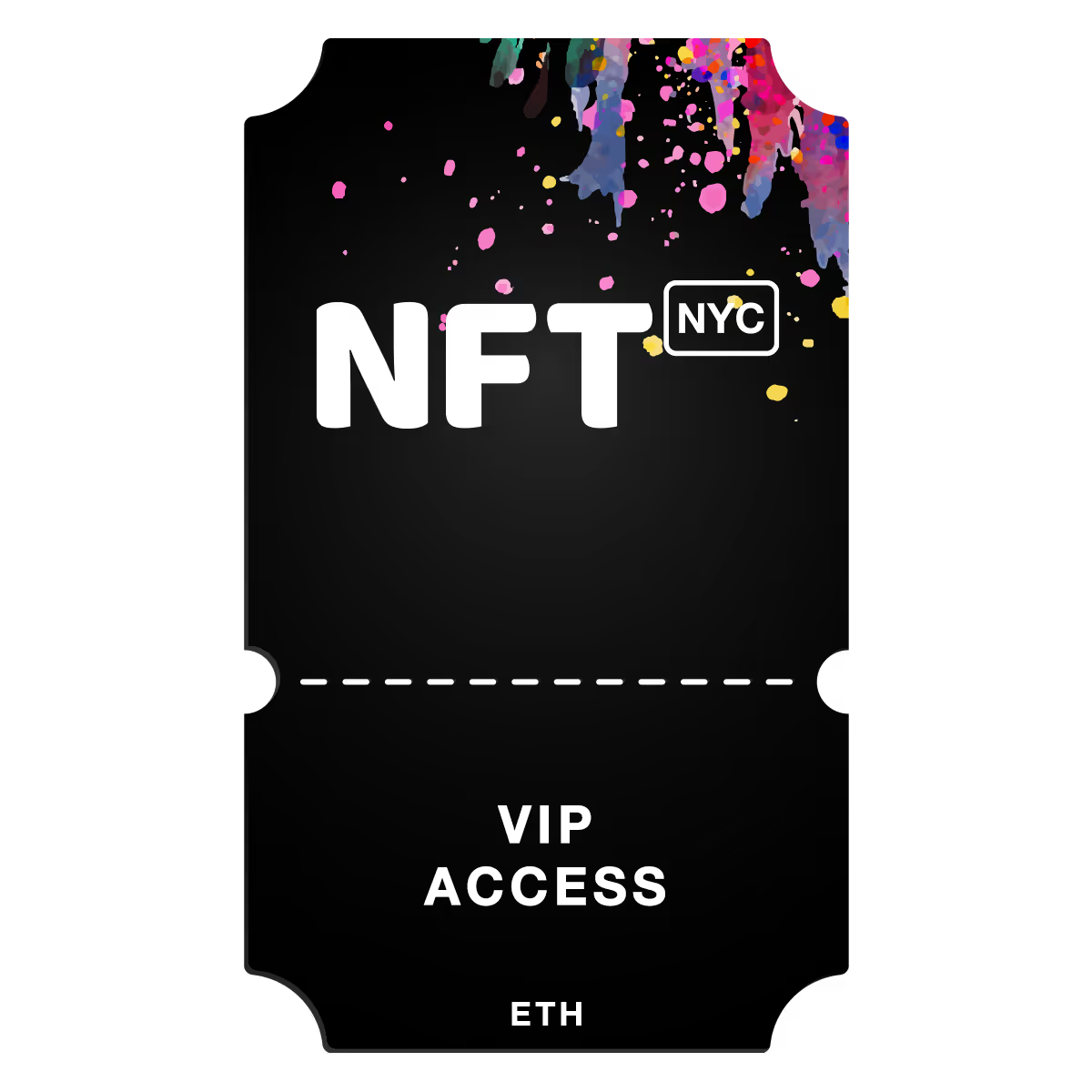
Crypto Stamp—a project by the Austrian Postal service—offered purchasers of official, physical stamps a convenient route into the world of digital collectibles. Each physical stamp featured a section with an opaque, scratch-off covering. Beneath the scratch-off area, purchasers would find a private key that held a small amount of ETH and a digital counterpart of the physical stamp, which they could then list for sale on OpenSea. The project was particularly interesting because it tied the scarcity of the digital asset to a useful physical asset, and engaged an existing community of collectors.
Dapper Labs, the creators of CryptoKitties, launched a tournament-style game called CheezeWizards. Interestingly, the game had a hard fork that led to the existence of both “unpasteurized” and “pasteurized” wizards, due to an initial bug in the smart contract. Featuring complex on-chain gameplay, the project highlighted the need for more standardization around NFT metadata, contract upgradeability, and the ability to ensure that auctions are appropriately updated when core attributes of the items change.
Casualties and resuscitation
These years were not without casualties. Nearly all of the hot potato games of early 2018 are now dead (though the assets still live for viewing on OpenSea). Fascinatingly, some of these projects were brought back to life by community members. Both CryptoAssault and Etheremon (now Ethermon) have been revived by their community. There was also a failed attempt to bring CryptoCelebrities back to life through a celebrity breeding game.
Non-fungible token myths
Now that we’ve given an overview of the space, let’s talk about misconceptions.
Scarcity alone drives demand
In the early days of the non-fungible token ecosystem, there was a belief that users would care about the provable scarcity of NFTs, and that they’d rush to buy NFTs simply because they were on a blockchain. Instead, we think demand is driven by more traditional forces: utility and provenance. Utility is the obvious one: I’m willing to buy an NFT ticket because it lets me into a conference, I’m more willing to buy a piece of art if I can show it off in a virtual world, and I’m willing to buy an item if it gives me special abilities in a game. The concept of provenance encapsulates the story behind an NFT. Where did it come from? Who’s owned it in the past? As the space matures, the stories of interesting NFTs grow more complex and start to meaningfully impact a token’s value.
Smart contracts mean assets last forever
There was also the belief that just because a smart contract was deployed, the assets would last forever. This overlooked the fact that there are other entities (websites, mobile apps) that serve as the portal for regular users to interact with these applications. If these portals go down, the assets lose a lot of their worth. Of course, there may be a future where decentralized applications can be deployed in a fully distributed, “unstoppable” way, but for now, we live very much in a hybrid world.
Abstracting the chain away will solve all our problems
In 2018 and 2019, some projects took the approach of “abstracting away the blockchain”, hiding all the mechanics of NFTs to users by providing a hosted wallet with username-password authentication. This was an interesting approach because it allowed for the same streamlined onboarding experiences as centralized applications. The problem was that the interoperability with the NFT ecosystem (virtual worlds, wallets, marketplaces) was lost. We’ve found that projects that plug into the existing NFT ecosystem and perhaps sacrifice some pieces of usability in the short term tend to be more attractive to the current community of early adopters.
The Non-Fungible Token Market
Current market size
.avif)
The market for non-fungible tokens is still quite small, and somewhat harder to measure than the cryptocurrency market given the lack of spot prices for assets. For the purpose of this analysis, we focus on secondary trading volume (i.e., peer to peer sales of non-fungible tokens) as an indicator of market size. Using this metric, we estimate the current secondary market to be roughly $2 – $3 million USD in volume per month. In the last six months, the following projects led the charge:
Market growth
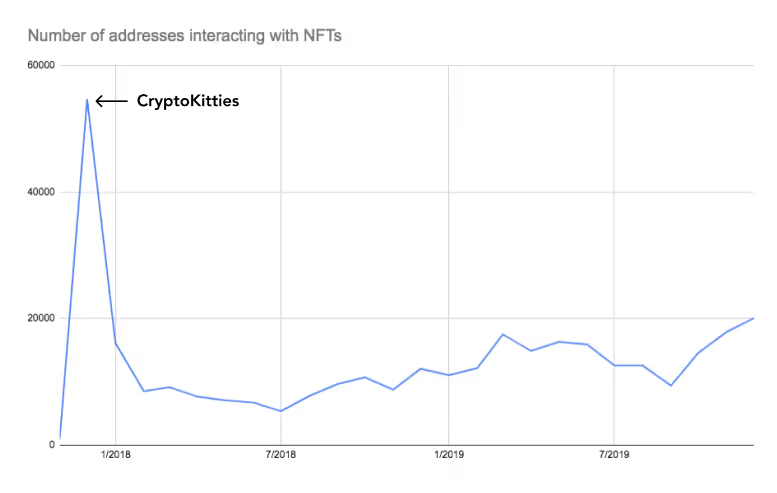
After the CryptoKitties bubble in late 2018, the number of unique accounts interacting with NFTs has grown slowly but steadily, from ~8,500 accounts in February of 2018 to over 20,000 accounts in December of 2019. The market seems to be driven by a core group of power users. On OpenSea, the median seller has sold $71.96 worth of stuff, whereas the average seller has sold $1,178 worth of stuff, indicating a large number of power sellers. Note that big accounts like official game accounts do drive the average up. The average OpenSea buyer has bought $943.81 worth of items and the median buyer has bought $42.72 worth.
<span class="blue-highlight"<code>On OpenSea, the median seller has sold $71.96 worth of stuff, whereas the average seller has sold $1,178 worth of stuff, indicating a large number of power sellers.!</code></span>
Given its earliness, probably the best way to measure the growth of the market is to look at a leading indicator: developer interest in the space. Over the last year, the number of mainnet ERC721 contracts has grown exponentially as new developers enter the space, hitting the 1,000s in June of 2019.
.avif)

Sale Mechanisms
NFTs are currently sold primarily for ETH on decentralized exchanges. Surprisingly little trading happens in stablecoins like DAI or USDC, likely due to the friction of acquiring stablecoins. Dutch auctions and fixed-price sales are frequently used for selling lower-ticket items, while English (eBay-style) auctions are a frequent choice for larger-ticket items, like ultra-valuable Gods Unchained cards or legendary game items. Bundles are also a very popular sale mechanism, with the percentage of bundle sales steadily growing to 20% in December of this year.
NFT Distribution
A question one might ask is: what’s the overlap between various NFT projects? Are communities around projects relatively isolated (Gods Unchained players only play Gods Unchained), or is there a large bleed-over between communities? Is a CryptoKitties enthusiast also likely to own an ENS domain and participate in the digital art ecosystem?
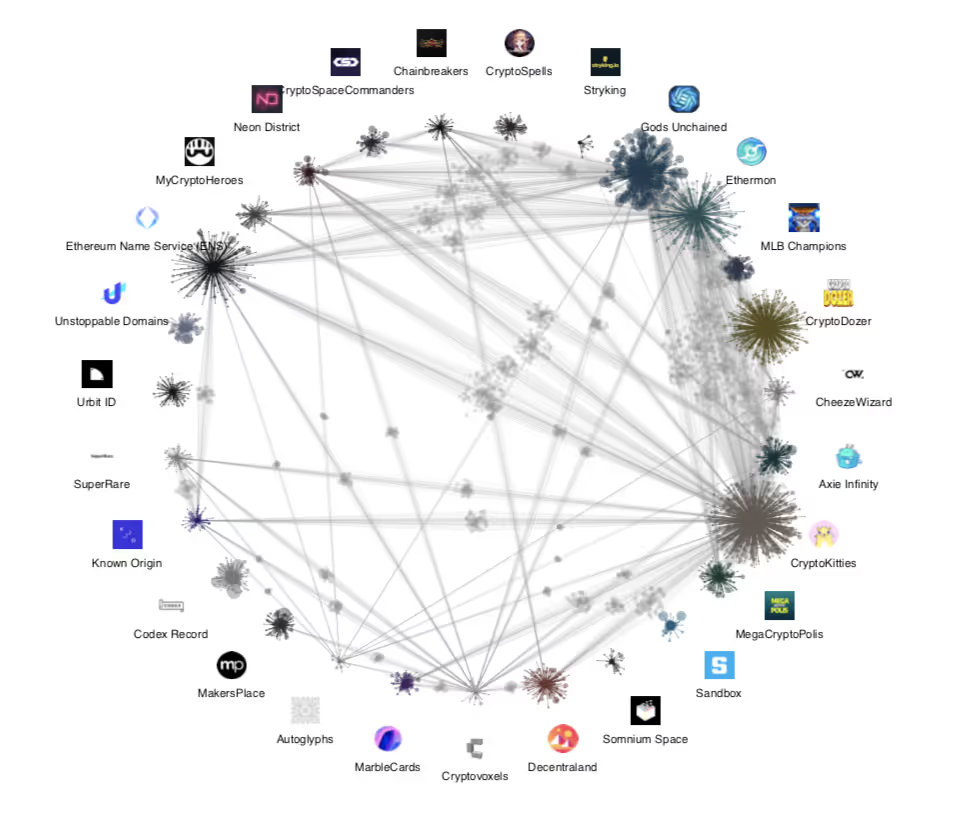
Takens Theorem, an anonymous but very friendly Twitter account with some fantastic analyses of the blockchain ecosystem (highly recommended follow!), conducted an analysis of the overlap between various NFT communities. The above is a network diagram based on raw data from about 400,000 addresses on OpenSea. On the outer ring, each network is made up of addresses that uniquely own a single type of NFT. The number of nodes pictured represents the number of nodes in the actual data — for example, thousands of addresses only own CryptoKitties. Nodes in these graphs are sized by how many they own.
In Gods Unchained, you can see that many addresses own many cards (a deck!). The light gray nodes that connect NFT projects represent prominent co-ownership patterns. There are thousands of addresses that own two game’s NFTs, seen on the right side of the overall plot. But there are other smaller regimes of co-ownership — such as between Cryptovoxels and Decentraland, and between ENS and many other projects, indicated by the connections “fanning out” across different projects.
What’s next for NFTs? Our 2020 predictions
If you made it this far, we congratulate you! We hope that you learned a lot about the fun, whacky world of NFTs and will be inspired to check out a few projects and perhaps even build one of your own. In our next post, we’ll be talking about the future of NFTs, with a set of predictions for the next couple of years. Subscribe to our newsletter for more updates!
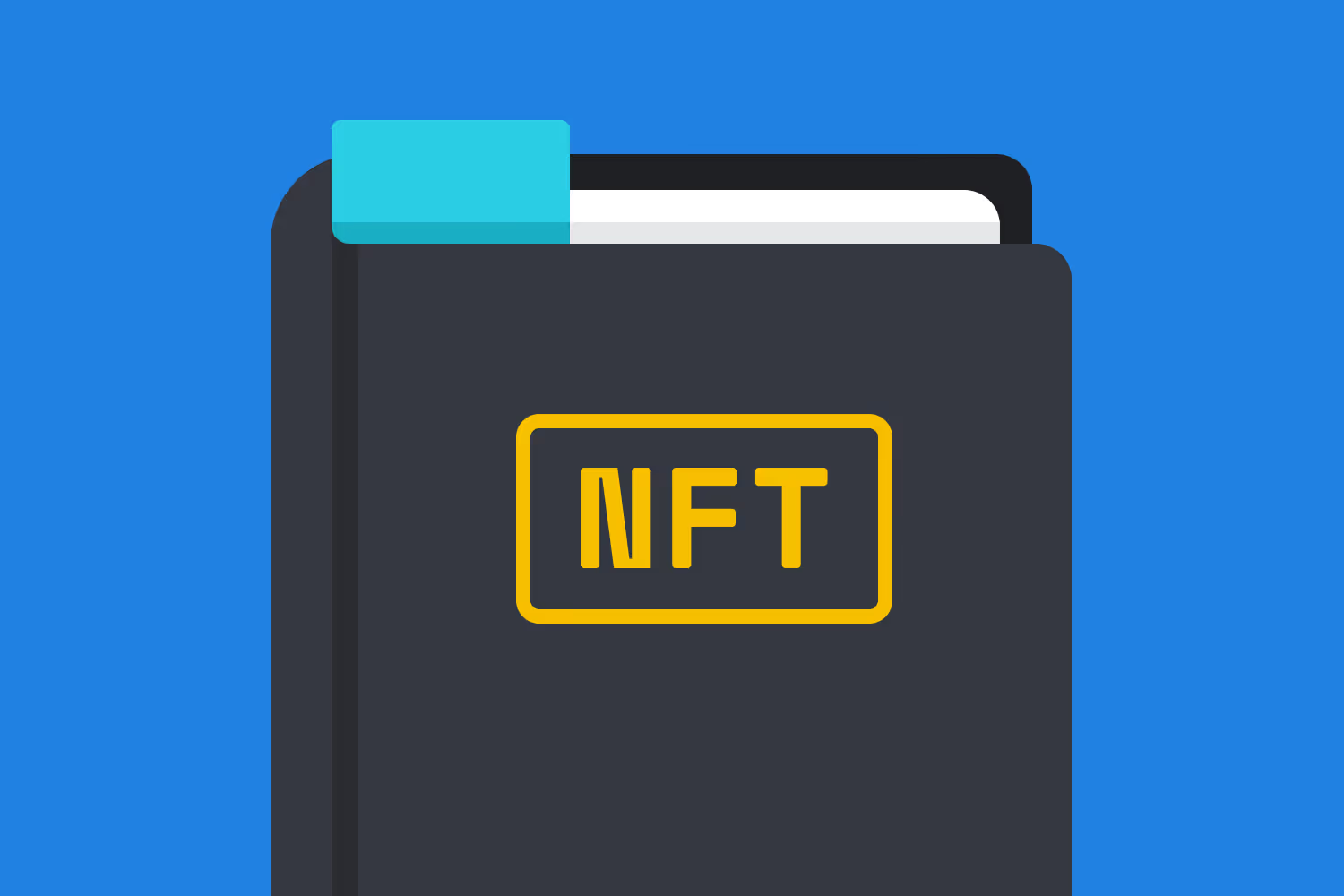


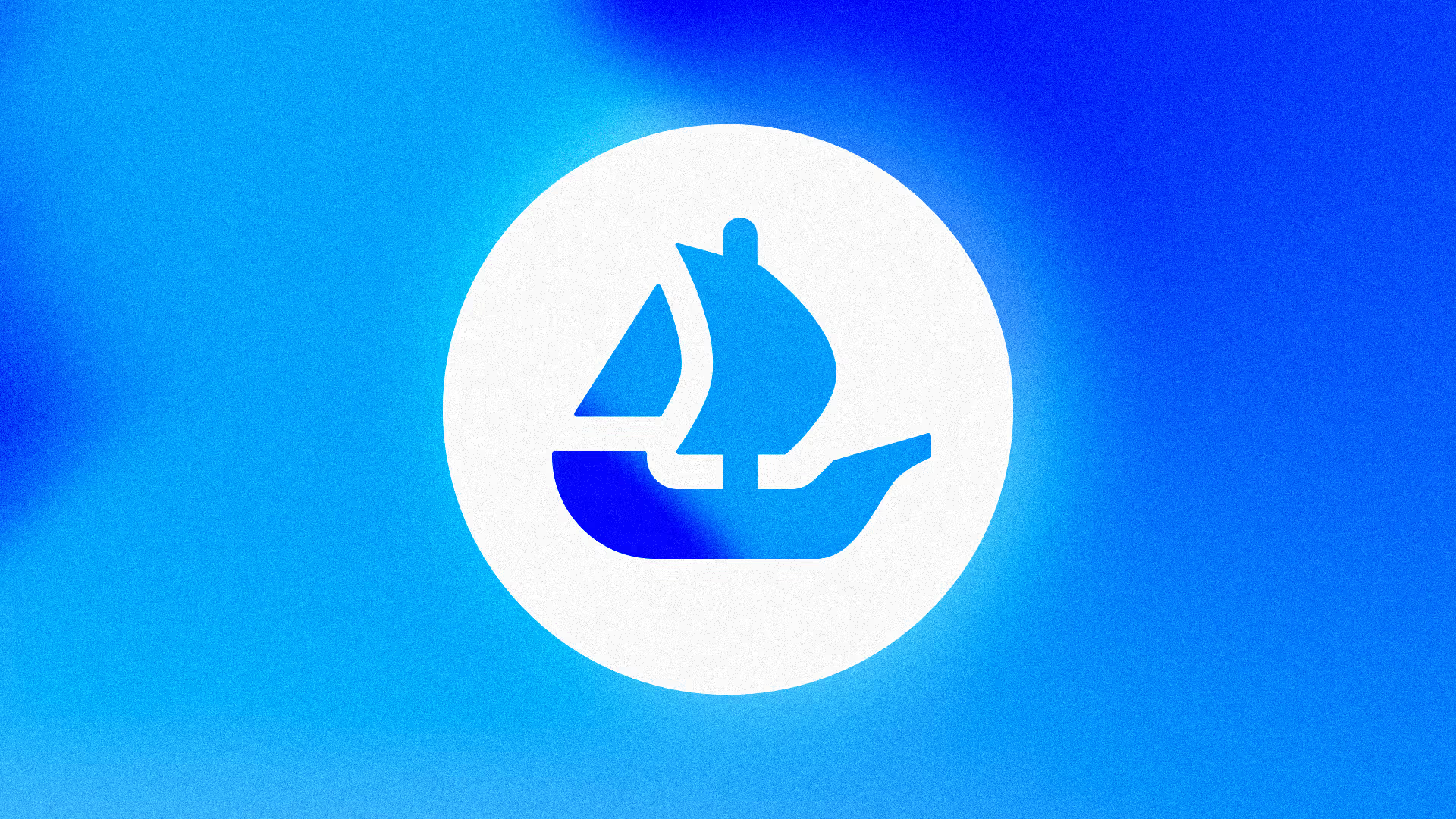
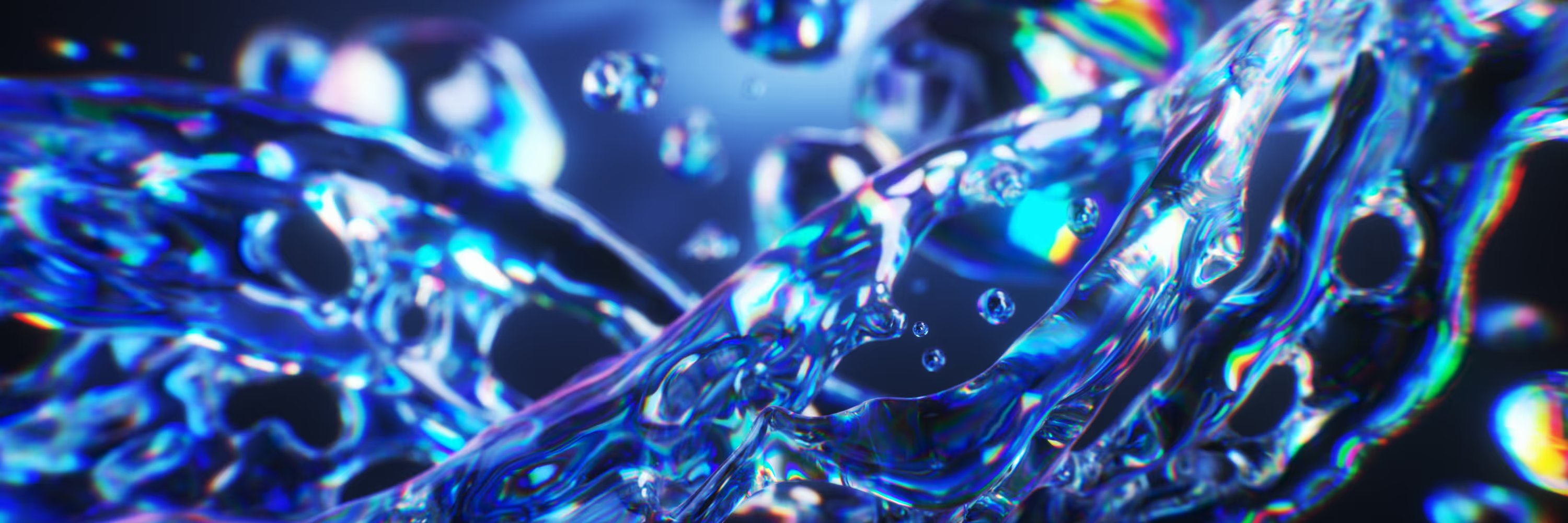
.avif)
.png)

.png)
.png)

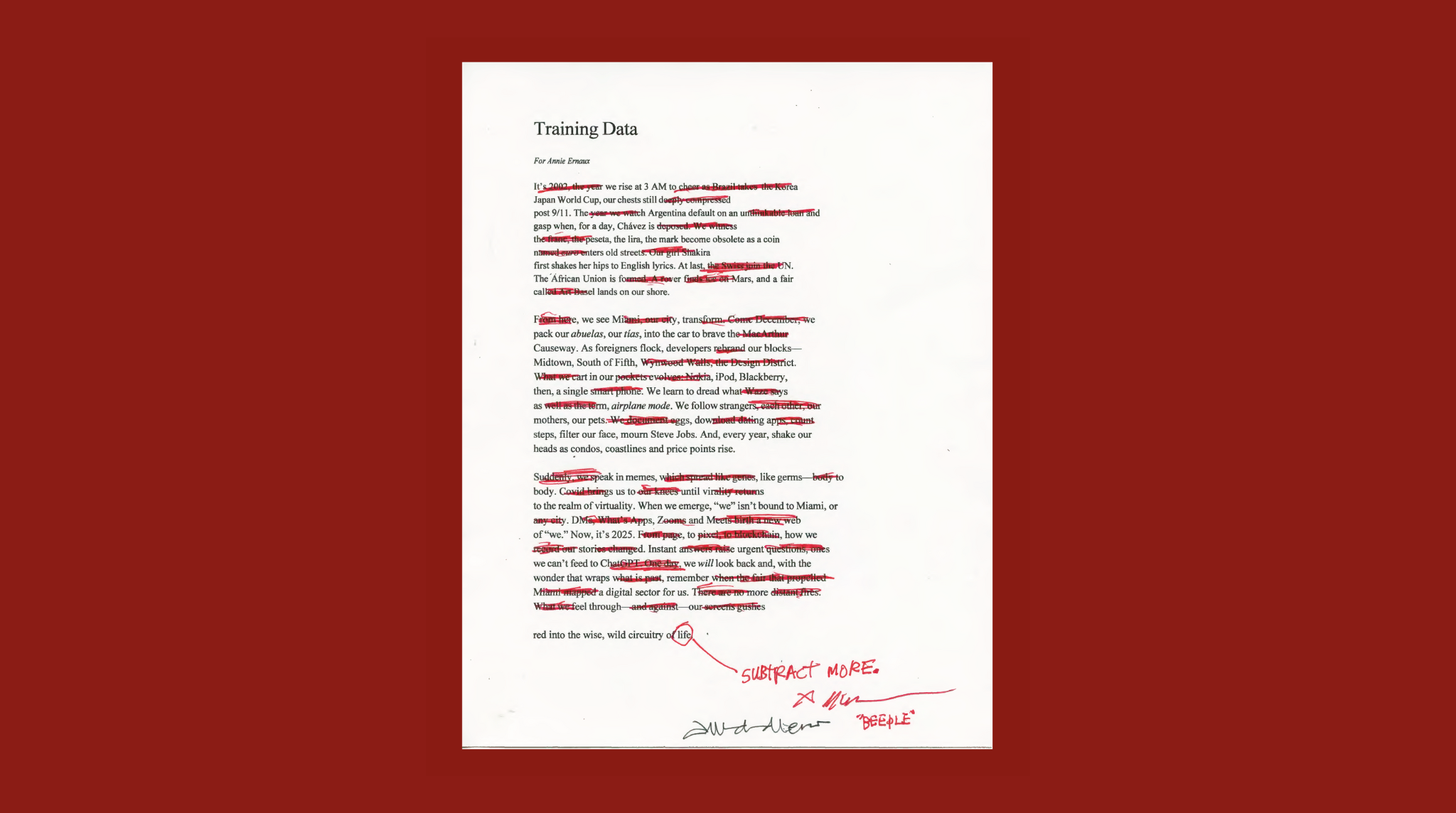

.png)